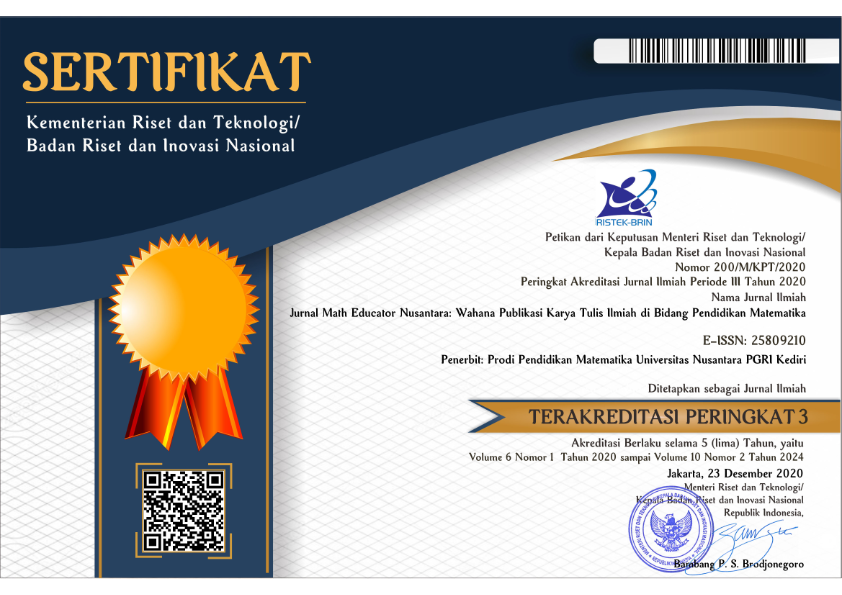The mathematical reasoning abilities of students in solving numeracy literacy problems reviewed from reflective-impulsive cognitive style
DOI:
https://doi.org/10.29407/jmen.v9i2.21273Keywords:
Mathematical Reasoning, Numeracy Literacy Problems, Reflective-Impulsive Cognitive StyleAbstract
Mathematical reasoning is one of the five fundamental mathematical abilities that students need to master. The ability of mathematical reasoning is required by students to solve numeracy literacy problems. One of the factors influencing students' mathematical reasoning abilities is their reflective-impulsive cognitive style. This research aims to describe students' mathematical reasoning abilities in solving numeracy literacy problems in terms of the reflective-impulsive cognitive style. The research adopts a qualitative approach, with 6 students from class 9B at SMP Al Falah Ketintang Surabaya selected using purposive sampling. The research instruments include the MFFT cognitive style test sheet, numeracy literacy test sheet, and an interview guide that has been validated by three validators. Data analysis techniques involve data collection, data condensation, data presentation, and drawing conclusions. Based on the analysis and discussion, it is concluded that the mathematical reasoning abilities of students with a reflective cognitive style, particularly in the indicator of performing mathematical manipulations, are not yet well fulfilled. Similarly, the mathematical reasoning abilities of students with an impulsive cognitive style, especially in the indicator of constructing evidence and providing reasons/evidence for the correctness of the solution, are not yet well fulfilled. The mathematical reasoning abilities of students with both reflective and impulsive cognitive styles in solving numeracy literacy problems are more dominant in the moderate and low categories.
References
Ayal, C. S., Kusuma, Y. S., Sabandar, J., & Dahlan, J. A. (2016). The Enhancement of Mathematical Reasoning Ability of Junior High School Students by Applying Mind Mapping Strategy. Journal of Education and Practice, 7(25), 50-58.
Daraini, R. (2012). Pengaruh Pembelajaran Berbasis Multimedia dan Gaya Kognitif Terhadap Kemampuan Pemecahan Masalah Matematika. Jurnal Teknologi Pendidikan. 5(2): 236-243.
Heuvel-panhuizen, M.V.D., & Drijvers, P. (2014). Realistic Mathematics Education. Encylopedia of Mathematics Education.
Kenny, R. F. (2007). Digital narrative as a change agent to teach reading to media-centric students. International Journal of Educational and Pedagogical Sciences, 1(11), 720-728.
Khanifah, K., Sutrisno, S., & Purwosetiyono, F. D. (2019). Literasi Matematika Tahap Merumuskan Masalah Secara Matematis Siswa Kemampuan Tinggi dalam Memecahkan Masalah Matematika Kelas VIII. JKPM (Jurnal Kajian Pendidikan Matematika), 5(1), 37-48. DOI: http://dx.doi.org/10.30998/jkpm.v5i1.4544
Miles, M.B., Huberman, A.M., & Saldana, J. (2014). Quantitative Data Analysis. SAGE Publications.
Miswati, V. D., Sugiyanti, S., & Pramasdyahsari, A. S. (2021). Profile of creative thinking skills in solving math problems on reflective and impulsive cognitive forces. Jurnal Math Educator Nusantara: Wahana Publikasi Karya Tulis Ilmiah Di Bidang Pendidikan Matematika, 7(1), 37-47. https://doi.org/10.29407/jmen.v7i1.15845
NCTM. (2000). Principle and Standards for School Mathematics. Reston, VA: NCTM
OECD. (2019). PISA 2018 Assesment & Analytical Framework. OECD Publishing.
Purwanto, Z. A., et al. (2023). Kemampuan Penalaran Matematis Peserta Didik Berdasarkan Dimensi Bernalar Kritis. AoEJ: Academy of Education Journal. 14(2): 316-325
Sakina. (2018). Identifikasi Penalaran Matematis Siswa Kelas VIII dalam Memecahkan Masalah Matematika di SMP Negeri 1 Pangkalan Lampam. Skripsi. Universitas Islam Negeri Raden Fatah Palembang.
Sari, R.H.N. (2015). Literasi Matematika: Apa, Mengapa & Bagaimana?. Prosiding Seminar Nasional Matematika & Pendidikan Matematika UNY, 713-720.
Somakim, Suharman, A., Madang, K., & Taufiq. (2016). Developing Teaching Materials PISA-based for Mathematics and Science of Junior High School. Journal of Education and Prcatice. 7(13): 73-77.
Suhandri., Nufus, H., & Nurdin, E. (2017). Profil kemampuan Koneksi Matematis Mahasiswa dalam Memecahkan Masalah Matematika Berdasarkan Level Kemampuan Akademik. Jurnal Analisa. 3(2), 115-129.
Sulisawati. (2013). Pengaturan Diri Siswa SMP dengan Gaya Kognitif Reflektif-Impulsif dalam Menyelesaikan Masalah Aljabar. Tesis. Surabaya: Universitas Negeri Surabaya.
Sulistiawati. (2014). Analisis Kesulitan Belajar Kemampuan Penalaran matematis Siswa pada Materi Luas Permukaan dan Volume Limas. Proceeding Seminar Nasional Pendidikan Matematika, Sains, dan TIK. Tangerang: STKIP Surya.
Downloads
Published
Issue
Section
License
Authors who publish with this journal agree to the following terms:
- Copyright on any article is retained by the author(s).
- The author grants the journal, the right of first publication with the work simultaneously licensed under a Creative Commons Attribution License that allows others to share the work with an acknowledgment of the work’s authorship and initial publication in this journal.
- Authors are able to enter into separate, additional contractual arrangements for the non-exclusive distribution of the journal’s published version of the work (e.g., post it to an institutional repository or publish it in a book), with an acknowledgment of its initial publication in this journal.
- Authors are permitted and encouraged to post their work online (e.g., in institutional repositories or on their website) prior to and during the submission process, as it can lead to productive exchanges, as well as earlier and greater citation of published work.
- The article and any associated published material is distributed under the Creative Commons Attribution-ShareAlike 4.0 International License













